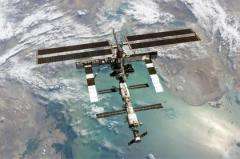Global student space experiments transformed

(Phys.org)—Space experiments dreamed up by three teenage winners of an international contest that will be streamed live on YouTube from the International Space Station Sept. 13 were made flight-ready by a University of Colorado Boulder space center.
The two winning experiments—one of which tests the ability of spiders to learn how to catch prey in the low-gravity of space, and the other which investigates how nutrients and compounds affect virulent bacteria growth in space—were announced in March. The contest is sponsored by YouTube, Lenovo and Space Adventures with the involvement of NASA, the European Space Agency and the Japanese Space Agency.
"We took the ideas of the two winning experiments and transformed them into actual experiments that could be conducted in space," said Stefanie Countryman, the business manager and outreach coordinator for BioServe Space Technologies, a NASA-sponsored center located in CU-Boulder's aerospace engineering sciences department. The CU team also manifested the payload on an unmanned Japanese HTV rocket, conducted safety verifications and trained the astronaut flight crew on using BioServe hardware aboard the International Space Station, or ISS, for the project.
The global initiative sponsoring the contest is a new program known as YouTube Space Lab. YouTube Space Lab is one component of YouTube for Schools, a program that allows educators to access YouTube's broad library of educational content from inside their school network. The contest generated more than 2,000 entries.
The student winners are Amr Mohamed, 18, of Alexandria, Egypt, who developed the idea for the spider experiment, and Dorothy Chen and Sara Ma, both 16, of Troy, Mich., who created the idea for the bacteria study. BioServe completed all of the mission integration and operations work for the two experiments and hand-delivered the loaded space flight hardware to the Tanegashima National Space Flight Center in Japan for launch to ISS on July 21.
The live, 45-minute YouTube Space Lab program stream from ISS, slated for 8:30 a.m. MDT on Sept. 13 will be hosted by Bill Nye "The Science Guy" and will include Mohamed, Chen and Ma. The winning experiments—selected by a panel that included British theoretical physicist Stephen Hawking, two NASA administrators, European Space Agency and Japanese Space Agency astronauts and Cirque de Soleil founder Guy Laliberte—will be performed by NASA astronaut Sunita Williams.
Countryman, who also will be part of the YouTube Space Lab live stream as she describes the role of BioServe in the project to Nye, said she was surprised by the sophistication of some of the experiments entered in the contest. "Seeing the level of intellect, not only from the top two winners but from six regional winners, makes us feel confident in the next generation of scientists and engineers," she said.
Countryman said BioServe worked closely with Paula Cushing at the Denver Museum of Nature and Science and MaryAnn Hamilton of the Butterfly Pavilion in Westminster, Colo., to obtain the jumping spiders and analyze their behavior. BioServe designed, developed and built the flight habitat for the spiders. Once aboard ISS, the habitat will be placed inside a BioServe-built device known as a Commercial Generic Bioprocessing Apparatus, or CGBA.
In addition, BioServe worked with AgraQuest in Davis, Calif., a company that manufactures and sells the bacteria strain B. subtilis, which will be used in the experiment by Chen and Ma. BioServe researchers worked with the students to design the experiment, which included 48 fluid processing devices carried in six Group Activation Packs built by BioServe and which have flown on dozens of space missions.
BioServe also developed an HD camera system to record high-resolution still images and HD video of the spider habitat, which included both the arachnids and their food, fruit flies, Countryman said. One of BioServe's CGBA devices on board ISS is providing power for the lighting system of the spider habitat and thermal control for both experiments, said Countryman.
As part of the contest, 14- to 18-year-olds, either alone or in groups of up to three, submitted videos describing their experiments to YouTube. All experiments submitted to the contest had to involve either biology or physics. People tuned into the YouTube Space Lab event can vote for their favorite experiments, Countryman said.
"For decades, one of our major thrusts at CU-Boulder's BioServe Space Technologies has been to provide educational opportunities for hundreds of thousands of K-12 students around the world," said Countryman. "This has been another opportunity for us to work with students on space payloads, a unique project that we hope will help steer many students from around the world into careers in the sciences."
BioServe is a nonprofit, NASA-funded center founded in 1987 at CU-Boulder to develop new or improved products through space life science research in partnership with industry, academia and government, said BioServe Director Louis Stodieck. Since 1991 BioServe has flown payloads on 40 NASA space shuttle microgravity missions and additional payloads on several Russian and Japanese space vehicles.
YouTube, a video-sharing website, is a subsidiary of Google. Lenovo, a global company headquartered in Morrisville, N.C., is the world's second-largest PC maker. Space Adventures, headquartered in Vienna, Va., provides flights for private citizens into space, including trips to the ISS.
To watch the winning experiments being performed on ISS go to youtube.com/spacelab" target="_blank">www.youtube.com/spacelab. For more information on BioServe visit www.colorado.edu/engineering/BioServe/.
Provided by University of Colorado at Boulder




















